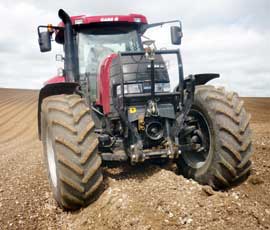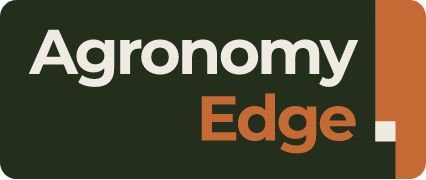VIDEO: Implement control opens possibilities

Auto-steering potato equipment is opening up some exciting new possibilities, as well as bringing immediate benefits for Yorkshire seed potato grower Andrew Manfield.
The target for Mr Manfield is to produce as many tubers as possible within the contracted target size range, from the shortest possible growing season, which reduces the risk of pests and diseases affecting quality.
Producing the best possible quality seed-beds is one of the routes he looks at carefully to increase tuber numbers, and therefore yields. “We all know potatoes are allergic to compaction and other problems in the seed-bed.”
And that’s where auto-steer machinery comes in: fitting wheelings between beds as accurately as possible helps avoid compaction and also improves the quality of the lift at harvest. “Nothing slows the harvester down like clod in the bed due to poor wheeling fit.”
Also, anything that optimises the structure of the bed minimises the risk of powdery scab, he says.
The technology Mr Manfield uses is real-time kinematics (RTK) auto-steer, which is highly accurate to around 2cm, and critically, he says, repeatable, so you can go to the same place each time. A fixed base station in combination with global positioning satellites is the key to the accuracy and repeatability.
But he quickly found that it wasn’t enough to just auto-steer the tractor, as many growers currently do. “Yes, when we used a tractor with auto-steer to ridge up we created visually straight line that were parallel to each other at the right spacing.
“Unfortunately we found they were visually straight and parallel in precisely the wrong places, due to the fact if you get on a slope or changing soil types the following implement will not track true to the tractor. It will slide down the slope or be pulled to the left or right, which makes it very difficult to do following operations – the ridges won’t be in the right places.”
Watch Andrew Manfield’s prototype machine in action, where the antenna are mounted between the ridging bodies to increase the accuracy of ridging.
That is because the accuracy of the system is at the antennae on the tractor, not at the wheels. “An awful lot can happen between the antennae on the tractor and where the implement hits the ground.”
It means both the tractor and implement need to be steered. “Fortunately, the Dutch have been working, particularly in their organic sector, on technology that will steer the tractor and implement to a high accuracy for mechanical weed control.”
The first implement that is self-steered is the plough. Mr Manfield uses a hydraulically variable-width plough, which opens and closes itself using a combination of a GPS RTK signal and some clever mathematics to work out where the back furrow should be to leave a perfectly straight furrow and have a perfect match up with the previous bout.
“Some people might ask – why bother? Well, the Dutch have found that subsequent operations are easier and much more effective where you have a high-quality ploughing operation to start the system off.”
All the following operations need to line up. “The first cultivation pass you do after ploughing is going to determine where your wheelings are for the rest of the season.”
For the ridging operation, he built a prototype machine with an antenna mounted between the ridging bodies, which controls a set of discs to steer the implement, while an antenna mounted to the chassis of the tractor positions the front wheels of the tractor in the bottom of the ridges.
“So effectively there are two integrated steering systems on that implement, controlled through one box in the cab.”
On the de-stoner, the antenna is mounted above the centre of the implement, allowing it to be auto-steered using a reverse-drive tractor. That has the advantage of allowing the operator to concentrate on the operation and not have neck strain from constantly looking over his shoulder, Mr Manfield says.
“It also considerably reduces the fights between the planter and de-stoner drivers, because the planter fits the bed perfectly every time.”
The end result is that the minimum of soil is trafficked, more soil remains in the ridge, and there is little or no compaction, he says. “So we don’t have damage or clods going up the harvester, and we’re using exactly the right amount of inputs because everything is spaced out perfectly.”
But it is the possibilities opened up by using the technology that excite Mr Manfield most. “For example, perhaps we can band spray some of our early inputs. If we can cut our chemical use by, say, 50%, that might be significant in the regulatory environment we seem to be heading towards.”
Another potential benefit is during flailing. “It is always an issue, because if we get out of a row, or the machine doesn’t fit properly, particularly if it is wet, we end up with a lot of damage, a lot of green tubers, scalping of the row and a difficult job for the operator.
“If he doesn’t have to steer the tractor and it fits properly that has to be a big benefit.”
And what about reverse-drive potato harvesting? “If you’re facing the machine you could potentially get better quality and more output out of existing trailed machinery without the expense of a self-propelled. I think any safety issues could be overcome.”
Earlier operations, such as de-stoning and planting could potentially be combined too.
“Machine control raises the possibility of one operator doing more. If he is not steering and is looking at the machine, why can’t we combine de-stoning with planting.“Modern planters always work best if they are level; modern de-stoners are self-levelled – the logic to me is you mount the planter somehow on the frame of the de-stoner, which is levelled.
“It probably isn’t an engineering challenge that couldn’t be overcome and straight away you take an operator and tractor out of the equation. It could have huge cost savings.”

